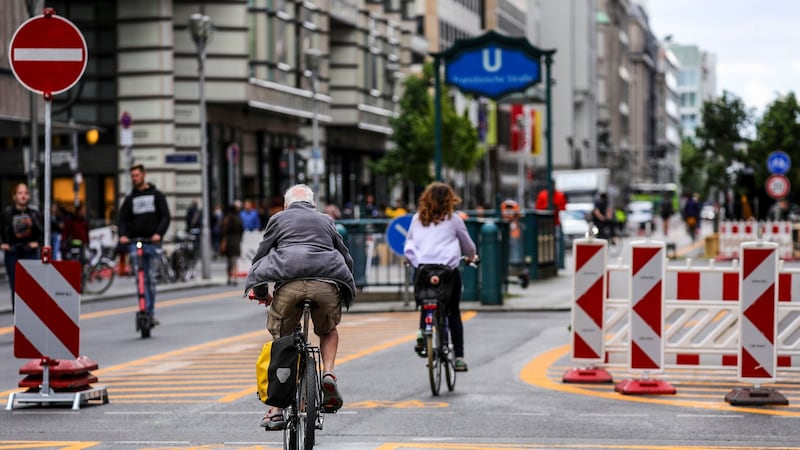It’s Tuesday lunchtime and I’m writing this sitting in the middle of Berlin’s Friedrichstrasse. Given the usual traffic levels on the street, sitting here would normally be a quick way to end it all. But not today.
Last weekend, while all eyes were on the nearby Covid-19 protests, the city government closed off to vehicles eastern Berlin’s main north-south thoroughfare. The two traffic lanes are now two cycle lanes. Bays where cars are usually parked have been turned into pop-up seating areas with benches, seats and trees in pots. Like other cities, during the Covid-19 pandemic Berlin has embraced pop-up cycle lanes across the city, but this takes things to a whole new level.
“It’s a game changer, a space changer,” says Sophie, a 32-year-old office worker enjoying her pasta salad in a seating bay on the streets. “It’s only been a few days but you can see people are so grateful.”
As we talk, people wander the street around us in a daze, taking pictures or standing to marvel at the space – and the quiet. The street looks like an architectural rendering come to life.
The woman behind the calm Friedrichstrasse is Berlin’s city-state transport minister Regine Günther, of the local Green Party. For her the project is about rethinking and rebalancing public space.
“The concept that only cars are allowed through has outstayed its welcome and is reaching its limits,” she said. “The street has lost its attractiveness over the years, if we can animate people to spend more time here rather than hurrying through, more will be bought.”

Berlin’s Friedrichstrasse is no natural beauty: a handful of historic buildings, some renovated East German blocks and many faceless 1990s architectural boxes.
In the prewar years, Friedrichstrasse was a lively place day and night that philosopher Martin Heidegger said had an “air of artificial, cultured, mean and refined sexuality”.
“People,” he warned later, “lost their souls here.”
The street lost most of its buildings in the war and its soul in the postwar era, truncated by the Berlin Wall and the notorious Checkpoint Charlie border crossing between east and west Berlin.
Hopes were high in the post-unification years that Friedrichstrasse could regain its place as one of Europe’s major streets. Architects such as Philip Johnson were recruited to fill vacant lots, but with very mixed results.
The buildings here change hands every few months, the rents are ridiculous and retailers are just giving up
Car traffic was the only growth area and today the post-unification euphoria has long gone and, with it, many tenants. Dozens of shopping units are empty, squeezed out by high rents demanded from investor landlords.
By day, the high-end shops attract few locals; by night, the planning emphasis on offices rather than apartments means the street is dead.
For Bianca, a local shop worker on her lunch break, the rethinking of the street is a welcome start for an overdue debate, catalysed by the ongoing pandemic: to whom does the city belong?
“The buildings here change hands every few months, the rents are ridiculous and retailers are just giving up,” she said. “We need to talk about these deep structural problems. A few benches and trees in pots are fine, but it’s a bit half-hearted.”
Maria and Paul from western Berlin agree. They came across town to have a look but think the transformation only highlights how little there is here for ordinary people like them.
“Not so much as a sausage stand,” says Paul in a wounded voice.
“And no bins,” adds Maria. “This is Berlin, it’s going to look grotty within a week.”
At the Leipziger Strasse end of the street, motorists with thunderous expressions turn away from the barriers. A lanky courier, rushing his package to its recipient on foot, has a few choice words to say about the car-free street that are not suitable for a family newspaper.
The car-free Friedrichstrasse is a six-month test, with a team created to study how the pedestrianised street works – or doesn’t work. The results will feed into a larger, long-term policy by Berlin’s city planners to put cars, and car-friendly planning, at the bottom of the heap behind pedestrians, cyclists and public transport users.
After Friedrichstrasse, debate is already under way to banish private cars from the Unter den Linden boulevard around the corner. After that, Günther has her eye on western Berlin’s showcase shopping mile, the Kurfürstendamm. But that’s all in the future.
As Sophie finishes her first al fresco Friedrichstrasse lunch, she has a final thought before getting back to work: “It’s a fascinating process to watch: people reclaiming their space from the sea of metal.”





















